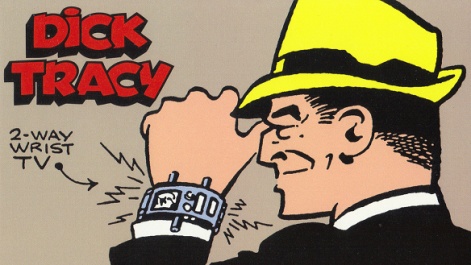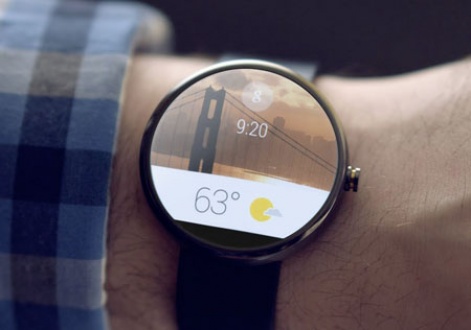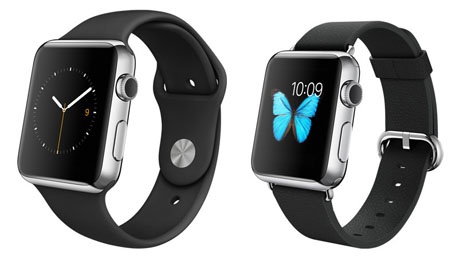The mobile games market has become saturated.
The gold rush is over, but that doesn't stop us all looking out for the next wave of tech disruption.
In 2015 our attention has moved away from the unconsole (Ouya/Gamestick) to the smartwatch.
However, is this truly an up-and-coming phenomenon or just one tech gadget too far?
Looking down
Smartwatches are not a new idea of course. Since the time of the Dick Tracy comics we have been fascinated by what we could put on our wrists.
I remember the excitement of my first digital watch. I had to press a button for the bright red LED numbers to appear. But before long it was replaced by a Casio calculator watch.
As the 1980s continued, as well as the addition of regular functions such as stopwatches and timers, we saw watches with games, initially number pattern games but in time replicas of simple arcade titles. However, even though there was a Legend of Zelda Game Watch, we didn't confuse them with Nintendo's classic Game And Watch devices.

By the 1990s, a watch-calculator alone was not longer enough. Watches with early data storage (for telephone numbers and memos) started appearing. I remember a Timex watch, arguably one of the first true smartwatches, which even had an optical connector allowing you to synchronise with your computer.
The trouble was that these devices were clunky and failed to deliver convenience.
Smartwatches are about 'The Second'.Oscar Clark
They were also fighting against a market where style was becoming more important than function.
Facing the future
So what's different now? Well, partly it's the widespread adoption of smartphone, but for me what's more interesting is the idea of the smartwatch as a companion device.
I think recent designs have stumbled on something which solves a genuine user problem. It's a problem is best exemplified by the old idea of the 'BlackBerry Twitch'.
When I had a BlackBerry a few years ago I hated the anxiety when a message came in - I didn't know if the message was from my family or my work. I didn't know if it was urgent or if I was in trouble.
I felt that I had to check every message and the time it took to get out my phone and read the message was just enough to give me time to a measurable level of stress; usually unfounded.
I soon found ways to turn off the unwanted messages but that meant that at times I'd miss useful information as well.

Having these notifications appear on my watch solves that problem.
For some reason knowing I can check my watch easily saves me from feeling the compulsion to pull my phone out of my pocket, get it out of its case and check.
It's so easy and so natural I don't get the anxiety and indeed it's a useful distraction to swipe through notifications on the watch screen - almost like a game.
It's also surprisingly easier to ignore than the phone. A buzz on my wrist is something I can come back to, but if it happens in my pocket that seems somehow more urgent but perhaps that's just me.
Compare this with other wearables like Google Glass, where the message persists in your vision and the awareness of a message or notification and interrupts your attention. No wonder the derogatory term 'glass-holes' was quickly invented.
As with any platform, games will lead the way in terms of application development.Oscar Clark
You can't choose to ignore Glass notifications as they arrive in the same way as you can on a watch. Checking your watch is at least a little more natural than looking away from the people you might be talking to.
One year on
I've been using a smartwatch in earnest for around a year now and it's taught me a number of things about the design constraints.
The first is the realisation that smartwatches are about 'The Second' (aka the 'Now').
They don't suit extended play experiences, at least those which require long concentration on the display.
Have you tried holding your arm up in a fixed position for a long time, while rapidly touching the screen with your other hand?
It gets surprisingly uncomfortable surprisingly fast. You also don't have the real-estate to have multiple clicks.
No, this is a medium for one-touch and, at least, with the current devices, you can't rely on the accuracy of that action although directional swipes do work pretty well.
Most of the modern devices have accelerometers too, something I still believe is an underutilised user experience tool, but again accuracy is a concern. Plus they are connected to your phone creating a huge range of possibilities including as a controller.
Positioning
As with any platform, games will lead the way in terms of application development and we already have a number of teams testing out this space.
Developers such as AMA, Spooky House and Handy Games are creating great and simple content, perfectly suited to watches already. So will this be the next gold rush?
I think there remain some fundamental problems before the market takes off.
Even selling watch apps raises questions. Will they need to have a dedicated app store? On Google Play it's currently quite hard to separate Android Wear apps from phone apps. Also the way the apps are delivered (for Android Wear and Tizen at least) currently means they are installed via the phone, so will that encourage consumers to expect to get watch version of games free when they buy the phone version too?
More fundamentally, will watches continue to be companion devices or will they have their own SIM cards and the associated mobile operator contracts?
This is a time for early mover developers to try out mobile watch game concepts.Oscar Clark
To me, that approach seems a dead end as long as operators want to charge you for separately for both contracts. (This was also the reason I didn't go for the Samsung Gear S.)
However, I did love the ability to take a call on my original Gear watch; something I can't do on my Android Wear watch. Battery life will always be a factor, but perhaps in time there will be a point when a watch and a tablet will be a better combination than a phone with a watch for some people.
Is there a role for a camera?
The most recent devices don't have one, and the camera on my original Gear watch was faulty within weeks. However, my gut tells me that this is a missing use-case and not just for video calls (for which the position of the camera on the Galaxy Gear was all wrong).
Give me two high quality waterproof cameras- one facing away and one facing me (and enough battery power) and I will be video blogging in no time.

Then there is the gold-plated elephant in the room...
I've yet to see the Apple Watch in the wild or any discussion of the app strategy for the device. However, on its arrival we are bound to see a market shift happen.
The countdown has started
All-in-all, this period reminds me of 1999 and the Diamond Rio.
We all wanted more convenience to enjoy all our music on the move, but the design and convenience factors weren't quite ready (neither was the legal framework of course but that's a different article).
Apple's iPod didn't arrive until 2001 but it wasn't until 2003 when third generation iPods supported PCs that it became an essential device.
For my money, the smartwatch won't become a massive consumer hit in 2015, although many people who like me love their tech will be wearing them.
Yet this remains a time for early mover developers to investigate and try out mobile watch game concepts.
The real market is coming soon, perhaps as early as the holiday season, and I for one am going to keep my eyes - and wrist - open on the future of wearables.





















